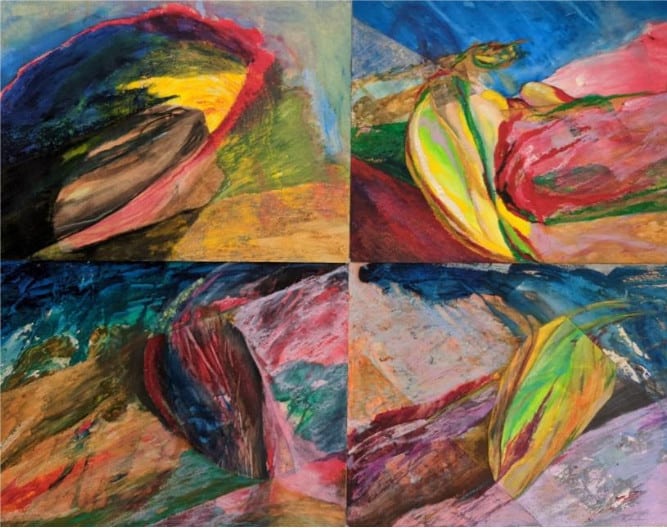
Scenes that depict compositional lines that intersect on the diagonal thrill people. My acrylic and oil painting, Spring 4, consists of four quadrants, evidenced in the horizontal and vertical lines that meet in the middle of the piece. Balancing the strong symmetry, each section contains diagonal lines that cross each other.
In the lower right, a grey swath crosses the space from the bottom to the top. A wide organic brown stripe spans the area above it. On top of the brown, a green and orange seed shape hovers, slicing through the brown.
Once you get used to detecting the directions and flows of shapes and colors, you can play at being a detective. Squinting the eyes help to discern directions of paint in each of the other quadrants. Observe whether the diagonal lines cross each other. These crosshair spots become emotional and aesthetic focal points. In the lower right quadrant, the green and orange seed shape grabs our eye for this reason.
Why are diagonal lines so powerful to humans? We relate to the world according to our body’s balance in space. When horizontal, we’re at rest. Flat landscapes at a distance are calming to us. Portraits with people standing, creating a vertical design, are active and grab our interest. Imagine your body on the diagonal: you’d be falling over, the most panic-inducing of all postures. That’s why, when our eyes see diagonal lines, they automatically become agitated, on alert.
I find the inner structure of an art work fascinating. The ancient Greeks explored this revelatory territory around 500 BC when they transformed their Kouros and Kore statues of young men and women: stiff symmetrical forms borrowed from the Egyptians, with equal weight on each leg, one foot slightly in front of the other. During this epoch, the Greeks created the radical Contrapposto. In this new Counterpose, the model bears all the weight on only one leg, the other is relaxed, knee bent. What we now consider a classic pose causes the hips and shoulders to rest at opposite angles, giving a slight s-curve to the entire torso. If I extended the angled lines of the shoulders and hips into the space around the figure, they would meet in this empty area. The implied intersecting lines create a vigorous and fascinating composition for the viewer’s active eye.

This Greek knowledge was lost during Europe’s medieval period, but rediscovered during the Renaissance. From then until now, artists have used this concept to plan their designs. When they desire a calm mood, horizontal lines prevail. But for intensity, artists know that diagonal lines in the underlying composition will excite the viewer and captivate their gaze, just as it does in Spring 4.
Kaethe Kauffman’s one-person exhibit, La Foresta, is at Castello Gallery 780 in Venice, Italy, April 19 to June 23, 2024. Castello Gallery 780 is affiliated with the Venice Biennale art fair.
